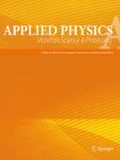Abstract
In this paper, a theoretical method is presented to calculate third-order nonlinear optical susceptibility resulting from electrostriction (TNSRE) in metamaterials. The presented model is based on homogenization and effective medium theory. We have demonstrated that electrostriction is the dominant mechanism in the enhancement and suppression of the TNSRE. To provide a comprehensive framework that includes different types of metamaterials, we examined all known effective elastic models and effective optical models separately. The numerical results showed that TNSRE has a little dependency on the frequency which decreases at higher frequencies.




Similar content being viewed by others
References
H. Ma, R. Xiao, P. Sheng, Third-order optical nonlinearity enhancement through composite microstructures. J. Opt. Soc. Am. B 15(3), 1022–1029 (1998)
M. Smith, C. Wolff, C.M. de Sterke, M. Lapine, B. Kuhlmey, C. Poulton, Stimulated Brillouin scattering in metamaterials. J. Opt. Soc. Am. B 33(10), 2162–2171 (2016)
M. Smith, B. Kuhlmey, C.M. de Sterke, C. Wolff, M. Lapine, C. Poulton, Metamaterial control of stimulated Brillouin scattering. Opt. Lett. 41(10), 2338–2341 (2016)
M. Kadic, G.W. Milton, M. van Hecke, M. Wegener, 3D metamaterials. Nat. Rev. Phys. 1(3), 198–210 (2019)
D.R. Smith, J.B. Pendry, Homogenization of metamaterials by field averaging. J. Opt. Soc. Am. B 23(3), 391–403 (2006)
D.R. Smith, J.B. Pendry, M.C. Wiltshire, Metamaterials and negative refractive index. Science 305(5685), 788–792 (2004)
Y.-R. Shen, The Principles of Nonlinear Optics (Wiley-Interscience, New York, 1984), p. 575
G. Agarwal, S.D. Gupta, T-matrix approach to the nonlinear susceptibilities of heterogeneous media. Phys. Rev. A 38(11), 5678 (1988)
G.L. Fischer, R.W. Boyd, Third-Order Nonlinear Optical Properties of Selected Composites (ACS Publications, 1997).
Z.-L. Zeng et al., First-principles study on the structural and electronic properties of double N atoms doped-rutile TiO2. J. At. Mol. Sci 1, 177–184 (2010)
F. Naseri, H. Shahmirzaee, Effect of correlation length between metallic nanoparticles in nonlinear properties of composition of oxide glass and metallic nanoparticles using SPFT. Iran. J. Phys. Res. 13(4), 355–361 (2014)
E.L. Buckland, R.W. Boyd, Electrostrictive contribution to the intensity-dependent refractive index of optical fibers. Opt. Lett. 21(15), 1117–1119 (1996)
S. Choudhary, R. Boyd, Tutorial on nonlinear optics. Front. Mod. Opt. 190, 31 (2016)
R.W. Boyd, Nonlinear Optics, 3rd edn. (Elsevier, Netherlands, 2003).
M.M. Braun, L. Pilon, Effective optical properties of non-absorbing nanoporous thin films. Thin Solid Films 496(2), 505–514 (2006)
K. Birch, M. Downs, An updated Edlén equation for the refractive index of air. Metrologia 30(3), 155 (1993)
M.J.A. Smith, B.T. Kuhlmey, C.M. de Sterke, C. Wolff, M. Lapine, C.G. Poulton, Electrostriction enhancement in metamaterials. Phys. Rev. B 91(21), 214102 (2015)
A. C. Wijeyewickrema and S. Leungvichcharoen, A review of analytical methods to determine effective mechanical properties of composites with spherical inclusions, in Proceedings of the Symposium on Environmental Issues Related to Infrastructure Development, Manila, Philippines, pp. 8–9 (2003)
C. Hsiao-Sheng, A. Acrivos, The effective elastic moduli of composite materials containing spherical inclusions at non-dilute concentrations. Int. J. Solids Struct. 14(5), 349–364 (1978)
L. Walpole, The elastic behaviour of a suspension of spherical particles. Q. J. Mech. Appl. Math. 25(2), 153–160 (1972)
A.K. Nandi, S. Datta, Improvement of soft tooling process through particle reinforcement with polyurethane mould. J. Braz. Soc. Mech. Sci. Eng. 33(3), 332–342 (2011)
G. Bourkas, I. Prassianakis, V. Kytopoulos, E. Sideridis, C. Younis, Estimation of elastic moduli of particulate composites by new models and comparison with moduli measured by tension, dynamic, and ultrasonic tests. Adv. Mater. Sci. Eng. 2010, 1 (2010)
Acknowledgements
This work was supported by NSAF, China No. U1830123, the National Natural Science Foundation of China (No. 61627802), and the High-Level Educational Innovation Team Introduction Plan of Jiangsu, China.
Author information
Authors and Affiliations
Corresponding author
Additional information
Publisher's Note
Springer Nature remains neutral with regard to jurisdictional claims in published maps and institutional affiliations.
Appendices
Appendix A
Here, we review different analytical methods to obtain the effective elastic properties of metamaterials [18, 21, 22].
-
(1)
Paul equation:
$${E}_{\mathrm{eff}}=\frac{{E}_{\mathrm{m}}^{2}+\left({E}_{\mathrm{m}}{E}_{\mathrm{i}}-{E}_{\mathrm{m}}^{2}\right){f}^{2/3}}{{E}_{\mathrm{m}}+\left({E}_{\mathrm{i}}-{E}_{\mathrm{m}}\right){f}^{2/3}\left(1-{f}^{1/3}\right)}$$where \({E}_{\mathrm{eff}}\) is effective the elastic modulus,\({E}_{m}\) is the elastic modulus of the matrix, and \({E}_{\mathrm{i}}\) is the elastic modulus of the inclusion.
-
(2)
Wu equation:
$$\frac{1}{{E}_{\mathrm{eff}}}=\left[\frac{1}{{E}_{\mathrm{m}}}-\frac{{\left(\frac{1}{{E}_{\mathrm{m}}}-\frac{1}{{E}_{\mathrm{i}}}\right)}^{2}}{\lambda \left(\frac{1}{{E}_{\mathrm{m}}}+\frac{\left(1-f\right)}{f{E}_{\mathrm{m}}}\right)}\right](1-f)+\frac{f}{{E}_{\mathrm{i}}}$$where \(\lambda\) is a parameter that has been found experimentally near to 1 for \({E}_{m}\ll {E}_{f}\) [22].
-
(3)
Voigt equation:
$${E}_{\mathrm{eff}}=f{E}_{\mathrm{m}}+(1-f){E}_{\mathrm{i}}$$ -
(4)
Reuss equation:
$$\frac{1}{{E}_{\mathrm{eff}}}=\frac{(1-f)}{{E}_{\mathrm{m}}}+\frac{f}{{E}_{\mathrm{i}}}$$ -
(5)
Einstein equation:
$${E}_{\mathrm{eff}}={E}_{\mathrm{m}}\left(1+2.5 f\right)$$ -
(6)
Guth and Smallwood Equation:
$${E}_{\mathrm{eff}}={E}_{\mathrm{m}}\left(1+2.5f+14.1{f}^{2}\right)$$ -
(7)
Euler and Van Dyck equation:
$${E}_{\mathrm{eff}}={E}_{\mathrm{m}}\left(1+\frac{kf}{1-sf}\right)$$where \(k\) and \(s\) take the values of 1.25 and 1.20, respectively.
-
(8)
Narkis equation:
$${E}_{\mathrm{eff}}=\frac{{E}_{\mathrm{m}}}{\psi (1-{f}^{1/3})}$$where \(1.4\le \psi \le 1.7\)
-
(9)
Mooney equation:
$${E}_{\mathrm{eff}}={E}_{\mathrm{m}}\mathrm{exp}\frac{1+2.5f}{1-5f}$$ -
(10)
Counto model:
$$\frac{1}{{E}_{\mathrm{eff}}}=\frac{1-{f}^{1/2}}{{E}_{\mathrm{m}}}+\frac{1}{\left[\left(1-{f}^{1/2}\right)/{f}^{1/2}\right]{E}_{\mathrm{m}}+{E}_{\mathrm{i}}}$$ -
(11)
Takahashi equation:
$$\frac{{E}_{\mathrm{eff}}}{{E}_{\mathrm{m}}}=1+\left(1-{\nu }_{\mathrm{m}}\right)f\frac{{E}_{i}\left(1-{2\nu }_{\mathrm{m}}\right)-{E}_{\mathrm{m}}\left(1-{\nu }_{\mathrm{i}}\right)+10\left(1+{\nu }_{\mathrm{m}}\right){E}_{\mathrm{i}}\left(1+{\nu }_{\mathrm{m}}\right)-{E}_{\mathrm{m}}(1+{\nu }_{\mathrm{m}})}{{E}_{\mathrm{i}}\left(1+{\nu }_{\mathrm{m}}\right)+{2E}_{\mathrm{m}}\left(1-{2\nu }_{\mathrm{i}}\right)+2{E}_{\mathrm{i}}\left(4-{5\nu }_{\mathrm{m}}\right)\left(1+{\nu }_{\mathrm{m}}\right)+{E}_{\mathrm{m}}(7-5{\nu }_{\mathrm{m}})(1+{\nu }_{\mathrm{i}})}$$where \({\nu }_{\mathrm{m}}\) and \({\nu }_{\mathrm{i}}\) are Poisson ratios of the matrix and inclusion, respectively.
-
(12)
Kerner equations:
$$\frac{{E}_{\mathrm{eff}}}{{E}_{\mathrm{m}}}=\frac{\frac{f{\mu }_{i}}{\left(7-{5\nu }_{\mathrm{m}}\right){\mu }_{\mathrm{m}}+(8-{10\nu }_{\mathrm{m}}){\mu }_{\mathrm{i}}}+\frac{f}{15(1-{\nu }_{\mathrm{m}})}}{\frac{f{\mu }_{m}}{\left(7-{5\nu }_{\mathrm{m}}\right){\mu }_{\mathrm{m}}+(8-{10\nu }_{\mathrm{m}}){\mu }_{\mathrm{i}}}+\frac{(1-f)}{15(1-{\nu }_{\mathrm{m}})}}$$ -
(13)
Hashin and Shtrikman bounds (upper and lower bounds):
$${{E}_{\mathrm{eff}}}_{H-S}^{\mathrm{upper}}=\frac{9\left({K}_{m}+\frac{f}{\frac{1}{{K}_{i}-{K}_{m}}+\frac{3(1-f)}{{3K}_{m}+4{\mu }_{\mathrm{m}}}}\right)\left({\mu }_{\mathrm{m}}+\frac{f}{\frac{1}{{\mu }_{\mathrm{i}}-{\mu }_{\mathrm{m}}}+\frac{6({K}_{m}+2{\mu }_{m})(1-f)}{5(3{K}_{m}+4{\mu }_{m}){\mu }_{\mathrm{m}}}}\right)}{3\left({K}_{m}+\frac{f}{\frac{1}{{K}_{i}-{K}_{m}}+\frac{3(1-f)}{{3K}_{m}+4{\mu }_{\mathrm{m}}}}\right)+\left({\mu }_{\mathrm{m}}+\frac{f}{\frac{1}{{\mu }_{\mathrm{i}}-{\mu }_{\mathrm{m}}}+\frac{6({K}_{m}+2{\mu }_{\mathrm{m}})(1-f)}{5(3{K}_{m}+4{\mu }_{\mathrm{m}}){\mu }_{\mathrm{m}}}}\right)}$$$${{E}_{\mathrm{eff}}}_{H-S}^{\mathrm{lower}}=\frac{9\left({K}_{i}+\frac{(1-f)}{\frac{1}{{K}_{m}-{K}_{i}}+\frac{3f}{3{K}_{i}+4{\mu }_{\mathrm{i}}}}\right)\left({\mu }_{\mathrm{i}}+\frac{(1-f)}{\frac{1}{{\mu }_{\mathrm{m}}-{\mu }_{\mathrm{i}}}+\frac{6({K}_{i}+2{\mu }_{\mathrm{i}})f}{5(3{K}_{i}+4{\mu }_{\mathrm{i}}){\mu }_{\mathrm{i}}}}\right)}{3\left({K}_{f}+\frac{(1-f)}{\frac{1}{{K}_{m}-{K}_{i}}+\frac{3f}{3{K}_{i}+4{\mu }_{\mathrm{i}}}}\right)+\left({\mu }_{\mathrm{i}}+\frac{(1-f)}{\frac{1}{{\mu }_{\mathrm{m}}-{\mu }_{\mathrm{i}}}+\frac{6({K}_{i}+2{\mu }_{\mathrm{i}})f}{5(3{K}_{i}+4{\mu }_{\mathrm{i}}){\mu }_{\mathrm{i}}}}\right)}$$
It is necessary to mention that Eq. (29) is also exact for a metamaterial consisting of spheres of different sizes embedded in a matrix [19].
Appendix B
In this section, we derived \(\frac{\partial \varepsilon }{\partial \omega }\) and \(\frac{{\partial }^{2}\varepsilon }{\partial \rho \partial \omega }\) for some materials.
For \({\mathrm{SiO}}_{2}\):
\({A}_{1}=0.6961663;{B}_{1}=0.0684043;{C}_{1}=0.4079426;{D}_{1}=0.1162414;{E}_{1}=0.8974794;{F}_{1}=9.896161;{{P}_{11}}_{1}=0.12;{{P}_{12}}_{1}=0.27\)
For \({\mathrm{As}}_{2}{\mathrm{S}}_{3}\):
\({A}_{2}=1.8983678;{B}_{2}=0.0225;{C}_{2}=1.9222979;{D}_{2}=0.0625;{E}_{2}=0.8765134;{F}_{2}=0.1225;{G}_{2}=0.1188704;{H}_{2}=0.2025; {K}_{2}=0.9569903;{L}_{2}=750;{{P}_{11}}_{2}=0.25;{{P}_{12}}_{2}=0.24\)
For \(\mathrm{Si}\):
\({A}_{3}= 3.4164 ;{ B}_{3}=0.085818; {C}_{3}=0.010149; H=1.2398419;{{p}_{11}}_{3}=-0.094;{{p}_{12}}_{3}=0.017\)
Rights and permissions
About this article
Cite this article
Khakpour, O., Yang, B., Chao, G. et al. Electrostriction-induced third-order nonlinear optical susceptibility in metamaterials. Appl. Phys. A 127, 376 (2021). https://doi.org/10.1007/s00339-021-04450-8
Received:
Accepted:
Published:
DOI: https://doi.org/10.1007/s00339-021-04450-8




